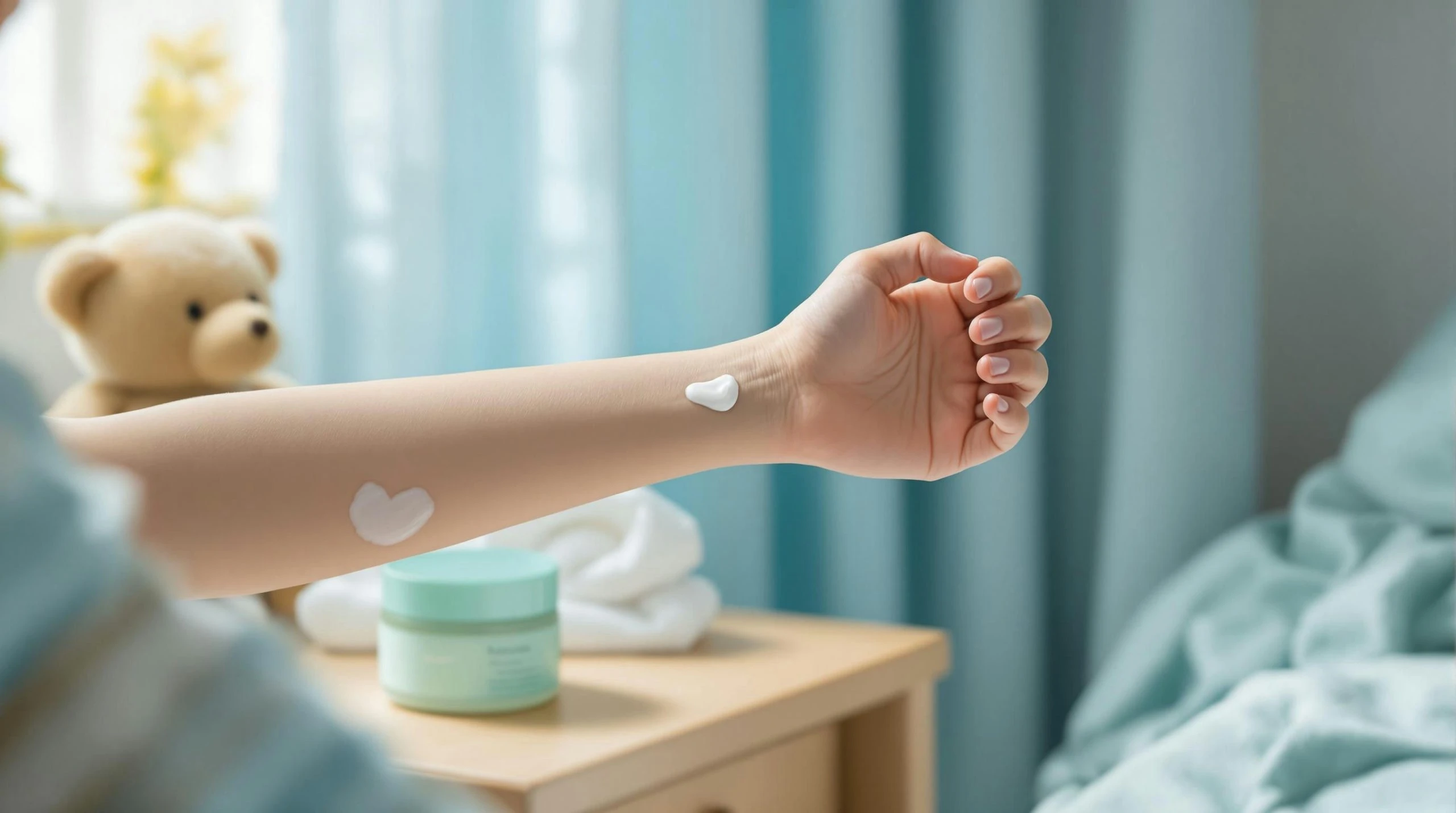Understanding Eczema in Children: Tips to Manage Flare-ups and Improve Comfort
Understanding Eczema in Children: Tips to Manage Flare-ups and Improve Comfort
Witnessing your child struggle with itchy, inflamed skin can be both concerning and frustrating. Eczema affects up to 20% of Canadian children, making it one of the most common skin conditions parents encounter. Beyond the physical discomfort, the constant scratching and visible rashes can impact a child’s sleep, mood, and even social interactions.
At Care& Family Health, our Nurse Practitioners frequently work with families navigating the challenges of childhood eczema. We understand that managing this chronic condition requires both medical guidance and practical daily strategies that fit into your family’s routine.
This guide will explore what causes eczema in children, how to identify triggers, effective treatment options, and practical steps to minimize flare-ups. Most importantly, we’ll provide realistic strategies to help your child find relief and comfort while supporting their overall wellbeing.
What Is Eczema and Why Do Children Get It?
Eczema, or atopic dermatitis, is a chronic inflammatory skin condition characterized by dry, itchy, and inflamed patches of skin. These patches typically appear on the face, behind the ears, on the scalp, neck, inside of elbows, behind knees, and on hands and feet.
The Underlying Causes
Childhood eczema develops from a combination of factors:
Genetic Predisposition: If parents or siblings have eczema, asthma, or allergies, a child has a higher likelihood of developing eczema. This genetic connection is why eczema often appears alongside other atopic conditions.
Skin Barrier Dysfunction: Children with eczema have a compromised skin barrier. Their skin struggles to retain moisture and provides less protection against irritants, allergens, and bacteria.
Immune System Responses: An overactive immune system often triggers inflammation in the skin when exposed to certain triggers.
Environmental Factors: Various external elements can trigger or worsen symptoms, from weather changes to household products.
Many Toronto parents notice their children’s eczema worsens during winter months when indoor heating reduces humidity levels and cold outdoor air further damages the skin barrier.
Recognizing Different Types of Eczema in Children
While atopic dermatitis is the most common form in children, understanding the different types can help with proper management:
Atopic Dermatitis: The most common childhood form, typically appearing in the first year of life and characterized by dry, itchy patches in typical locations like the face and flexural areas.
Contact Dermatitis: Develops when skin comes into contact with irritants (like soaps) or allergens (like certain metals).
Seborrheic Dermatitis: More common in infants (“cradle cap”), causing scaly, greasy patches on the scalp and sometimes face.
Dyshidrotic Eczema: Small, intensely itchy blisters on hands and feet, more common in older children.
Nummular Eczema: Circular, coin-shaped patches that may be mistaken for fungal infections.
Each type may require slightly different management approaches, so proper identification is important for effective treatment.
Common Triggers for Childhood Eczema Flare-ups
One of the most effective strategies for managing eczema is identifying and avoiding triggers. Common triggers include:
Environmental Triggers
Weather Changes: Cold, dry air in Toronto winters can be particularly harsh on sensitive skin, while sudden temperature changes year-round may trigger flares.
Allergens: Dust mites, pet dander, pollen, and mold can all provoke eczema symptoms.
Irritants: Household products containing fragrances, preservatives, and harsh chemicals often exacerbate symptoms.
Clothing and Fabric Triggers
Rough Fabrics: Wool and some synthetic materials can irritate sensitive skin.
Tight Clothing: Restrictive clothing that causes sweating or friction may worsen symptoms.
Laundry Products: Detergents, fabric softeners, and dryer sheets with fragrances or harsh chemicals.
Dietary Factors
While food allergies don’t cause eczema, they may trigger flare-ups in some children. Common food triggers include:
- Dairy products
- Eggs
- Nuts
- Soy products
- Wheat
- Certain fruits
Other Potential Triggers
Stress and Emotions: Stress can trigger inflammatory responses in the body that worsen eczema.
Sweat: Physical activity that causes sweating can lead to increased itching and irritation.
Infections: Bacterial, viral, or fungal infections can trigger or worsen eczema.
Creating an Effective Daily Skincare Routine
A consistent skincare routine is foundational for managing childhood eczema. Here’s a comprehensive approach:
Bathing Practices
Bath Temperature and Duration: Use lukewarm (not hot) water for baths/showers and limit time to 5-10 minutes.
Gentle Cleansing: Use fragrance-free, pH-balanced cleansers specifically formulated for sensitive skin. Avoid scrubbing the skin.
Patting Dry: Gently pat the skin dry with a soft towel rather than rubbing.
The “Soak and Seal” Method: After bathing, apply medication (if prescribed) and moisturizer within three minutes while the skin is still slightly damp to lock in moisture.
Moisturizing Strategy
Frequency: Apply moisturizer at least 2-3 times daily, focusing on problem areas.
Product Selection: Choose thick creams or ointments rather than lotions. Products labeled “fragrance-free” (not just “unscented”) are best.
Application Technique: Apply moisturizers in a downward motion, following the direction of hair growth to prevent folliculitis.
Clothing Considerations
Fabric Choices: Dress your child in soft, breathable fabrics like 100% cotton.
Layering: Use multiple thin layers in winter rather than one thick layer to prevent overheating.
Washing New Clothes: Always wash new clothing before wearing to remove potential irritants.
Medicated Treatments for Childhood Eczema
When home care isn’t enough, medical interventions can help manage symptoms:
Topical Medications
Corticosteroids: These anti-inflammatory medications come in various strengths. For children, healthcare providers typically recommend the lowest effective strength for the shortest duration needed.
Calcineurin Inhibitors: Non-steroidal options like tacrolimus (Protopic) or pimecrolimus (Elidel) can be especially useful for sensitive areas like the face.
PDE4 Inhibitors: Newer options like crisaborole (Eucrisa) work by reducing inflammation through a different mechanism than steroids.
Antibiotic Creams: When eczema patches become infected, topical antibiotics may be prescribed.
Oral Medications
Antihistamines: May help reduce itching, particularly at night, though they’re more effective for allergy-related eczema.
Oral Antibiotics: Prescribed when eczema becomes secondarily infected with bacteria.
Systemic Immunomodulators: For severe, resistant cases, medications that affect the immune system might be considered, though these are less common in children.
Emerging Treatments
Biologics: Newer injectable medications like dupilumab have been approved for children with severe eczema.
Light Therapy: Controlled exposure to specific wavelengths of UV light can reduce inflammation and itching in some cases.
Practical Tips for Managing Daily Life with Childhood Eczema
Beyond medical treatments, practical lifestyle adjustments can make a significant difference:
Creating an Eczema-Friendly Home Environment
Temperature and Humidity: Maintain consistent temperature and humidity levels. Consider a humidifier during winter months in Toronto when indoor heating makes air extremely dry.
House Cleaning: Use a vacuum with a HEPA filter, dust with damp cloths, and wash bedding weekly in hot water to reduce dust mites.
Pet Management: If pet dander is a trigger but removing pets isn’t an option, keep them out of the child’s bedroom and bathe them regularly.
Managing Eczema at School
Teacher Communication: Provide teachers with information about your child’s condition and any necessary accommodations.
Emergency Kit: Prepare a kit with moisturizer, prescribed medications, and safe hand soap for your child to keep at school.
Emotional Support: Help your child develop responses to questions about their skin to build confidence.
Sleep Strategies
Bedding: Use 100% cotton sheets and pillowcases and avoid wool or synthetic materials.
Night Scratching: Cotton gloves or socks over hands can reduce damage from unconscious scratching.
Temperature Control: Keep the bedroom cool, as overheating often triggers nighttime itching.
Addressing the Emotional Impact of Eczema
The psychological effects of eczema can be as challenging as the physical symptoms:
Supporting Your Child’s Emotional Health
Open Communication: Create space for your child to express frustrations about their condition.
Positive Focus: Highlight your child’s strengths and abilities rather than focusing on their skin condition.
Coping Strategies: Teach techniques like deep breathing or visualization to manage itching urges.
Managing Parental Stress
Self-Care: Remember that your wellbeing affects your ability to care for your child.
Support Networks: Connect with other parents of children with eczema through local or online groups.
Realistic Expectations: Understand that eczema management is about control, not cure, and there will be good days and challenging periods.
When to Seek Healthcare Support
While many cases of eczema can be managed at home, certain situations warrant professional attention:
Signs of Infection: Increased redness, warmth, swelling, yellow crust or pus, fever, or increased pain may indicate infection requiring treatment.
Sleep Disruption: If eczema consistently interferes with your child’s sleep despite home management.
Emotional Distress: When the condition begins affecting your child’s emotional wellbeing or social interactions.
Treatment Resistance: If prescribed treatments aren’t improving symptoms after the expected timeframe.
Unlike traditional walk-in clinics where you might see different providers for each visit, Care& Family Health offers appointments with the same Nurse Practitioner who can develop a comprehensive understanding of your child’s specific eczema triggers and responses to treatments. This continuity of care can be particularly valuable for chronic conditions like eczema that require ongoing management and adjustment.
Integrating Natural Approaches with Medical Treatment
Many families prefer to incorporate natural approaches alongside medical treatments:
Gentle Natural Remedies
Colloidal Oatmeal Baths: Adding colloidal oatmeal to lukewarm bathwater can soothe irritated skin.
Cold Compresses: Apply to relieve itching and inflammation during flare-ups.
Natural Fibers: Choose 100% cotton, bamboo, or other soft natural fibers for clothing and bedding.
Wet Wrap Therapy: This technique involves applying medication or moisturizer and covering the area with wet bandages followed by dry ones, which can dramatically improve severe flares.
Complementary Approaches
Probiotics: Some evidence suggests certain probiotics may help manage eczema, particularly in children with allergic tendencies.
Vitamin D: Research indicates a potential link between vitamin D deficiency and eczema severity, particularly relevant in Canada’s northern climate.
Essential Fatty Acids: Omega-3 supplements may help some children by supporting the skin’s barrier function and reducing inflammation.
Always discuss any natural or complementary approaches with your healthcare provider before implementation, as even natural remedies can interact with medications or be inappropriate for certain children.
At Care& Family Health, our Nurse Practitioners can help integrate evidence-based natural approaches with conventional treatments, providing unrushed appointments to fully discuss all your questions about complementary options.
Navigating the Seasons: Seasonal Strategies for Eczema Management
Children’s eczema often follows seasonal patterns, requiring adjusted approaches throughout the year:
Winter Strategies (Toronto’s Challenging Season)
Increase Moisturizing: Apply moisturizers more frequently during winter months.
Humidify Indoor Air: Counter the drying effects of heating systems with humidifiers.
Layer Clothing: Use cotton layers that can be removed to prevent overheating and sweating.
Protect from Elements: Cover exposed skin with appropriate barriers when outdoors.
Summer Approaches
Manage Heat and Sweat: Keep children cool, rinse off after sweating, and apply moisturizer afterward.
Swimming Considerations: Apply a barrier cream before swimming, rinse immediately after, and moisturize thoroughly.
Sun Protection: Use fragrance-free, mineral-based sunscreens designed for sensitive skin.
Transitional Seasons
Gradual Adaptation: Make slow transitions in skincare routines as seasons change.
Monitor New Triggers: Watch for reactions to seasonal allergens like pollen or mold.
Looking Forward: The Future of Childhood Eczema
For parents concerned about their child’s long-term outlook, understanding the progression of eczema can provide perspective:
Prognosis and Development
Many children experience significant improvement or complete resolution of eczema symptoms as they grow older. Research indicates that:
- Approximately 60% of children with eczema will experience major improvement or resolution by adolescence
- Early onset (before age 1) often has a better prognosis than later development
- More severe cases or those associated with other allergic conditions may be more likely to persist
Emerging Research and Treatments
Exciting developments in eczema research offer hope for improved management:
Microbiome Research: Studies on the skin’s bacterial balance may lead to new treatments that restore healthy skin bacteria.
Targeted Biologics: Newer medications targeting specific immune pathways show promise for moderate to severe cases.
Improved Barrier Repair: Advanced moisturizers and medical devices specifically designed to repair the skin barrier are under development.
Early Intervention: Research suggests that early, aggressive treatment may improve long-term outcomes.
Supporting Your Child’s Journey with Eczema
Managing childhood eczema is a marathon, not a sprint. Here are some final thoughts to guide your approach:
Consistency Is Key: The most effective management plans are those followed consistently, even when symptoms improve.
Adapt as Your Child Grows: Treatment needs will change as your child develops, requiring periodic reassessment.
Build Self-Management Skills: As children mature, gradually teach them to recognize triggers and manage their own skincare.
Celebrate Improvements: Acknowledge progress, no matter how small, to encourage continued adherence to treatment plans.
Regular check-ins with a healthcare provider who knows your child’s history can ensure treatment plans evolve appropriately. At Care& Family Health, our approach allows for these ongoing relationships, with unlimited appointments available to address concerns as they arise, rather than waiting until the next available appointment at a busy medical clinic.
With the right combination of medical support, home care routines, and emotional nurturing, most children with eczema can lead comfortable, confident lives while their families navigate this challenging condition.
Frequently Asked Questions About Childhood Eczema
Can my child “outgrow” eczema?
Many children do experience significant improvement as they get older, with about 60-70% seeing major improvement or resolution by adolescence. However, eczema patterns vary widely – some children may have periodic flares throughout life while others experience complete resolution. Maintaining good skin care habits remains important even during symptom-free periods, as this may help prevent recurrence.
Is food allergy testing recommended for all children with eczema?
Not necessarily. While food allergies can trigger eczema flares in some children, they aren’t the primary cause for most. At Care&, we typically recommend food allergy testing when there’s a clear pattern of flares after specific foods, when eczema is severe and persistent despite appropriate treatment, or when there are immediate allergic-type reactions to foods. Random testing without these indicators often leads to unnecessary dietary restrictions.
How do I know if my child’s eczema is infected?
Signs of infection include increased redness, warmth, swelling, oozing or weeping, yellow or honey-colored crusting, pus-filled bumps, increased pain (rather than just itching), and sometimes fever. Infected eczema requires prompt medical attention, as untreated skin infections can become serious. If you suspect infection, booking a medical appointment within 24-48 hours is advisable rather than waiting for symptoms to worsen.
How can I find time for a complex skincare routine when our family schedule is already busy?
Integrating eczema care into your family routine is challenging but critical. Start by identifying non-negotiable elements (like daily moisturizing) and build from there. At Care&, our Nurse Practitioners work with families to develop realistic management plans that fit their specific circumstances. For busy families, we might suggest bath-free days with quick “spot washing” followed by moisturizing, preparing pre-measured medication doses in advance, or designating specific times (like after school) for skin checks and care.
Can my child with eczema participate in normal activities like swimming and sports?
Absolutely! With proper management, children with eczema can and should participate in normal activities, including swimming and sports. Preparation is key: apply a thick moisturizer or barrier cream before swimming to reduce chlorine exposure, rinse immediately after swimming, and reapply moisturizer. For sports that cause sweating, quick rinses after activity followed by moisturizing can prevent flares. Helping children participate normally while managing their condition promotes both physical and emotional wellbeing.
Less Wait Time, More Face Time
Visit www.careand.ca to register
Contact Information:
📞 Phone: +1-647-951-4770
📧 Email: helpdesk@careand.ca
🌐 Website: www.careand.ca
Disclaimer:
This article is for informational purposes only and does not constitute medical advice. Always consult with a qualified healthcare provider for personal medical guidance. The information provided is general in nature and may not apply to individual circumstances.







